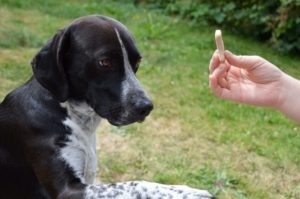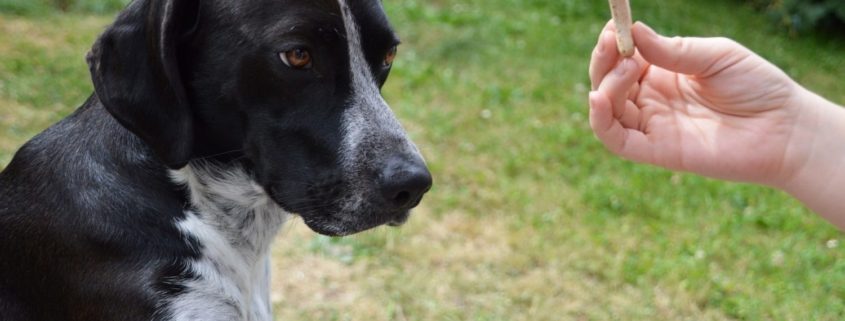Ask Crystal: Outside vs Inside
Welcome to “Ask Crystal,” where you can ask your pet behavior questions! You can submit your question for Crystal at the bottom of the page!
Dear Crystal,
Our recently adopted dog seems to be very anxious inside the house. She paces a lot and stands at the door and whines. We let her into the backyard, and she seems much more relaxed out there. She runs around and seems quite content out there. She also doesn’t really seem to know what to do inside the house. She jumped up on the dining room tables and jumps up against the doors and windows. She is just all over the place. She is such a sweet dog and we would really like her to be inside so she can be a part of the family, but I am not sure how to help her to calm down. Any suggestions?
Sincerely,
Outside Pup or Inside Pup
Dear Outside,
It does sound like based on the information you are giving that your dog was likely an outdoor dog. It is possible to make that transition, but it is going to take some time and patience on your part. Remember that no one ever taught your pup the rules of living inside the house, so everything is going to be new and exciting. I like to suggest that people think of their dogs as a toddler. Would you get mad at a toddler for getting into things or try to prevent them from getting into them? Dogs have the mentality of a 2-year-old so it’s a fitting analogy.

Since she is experiencing anxiety at being inside, it would be preferable if you have a secure outdoor space where she can spend her time. Be aware that dogs are much more likely to run away in the first few weeks of adopting. They are experiencing high levels of stress and they don’t know you or their new surroundings. If your dog is large or medium size, the fencing needs to be at least 6 feet high in most cases. You may consider purchasing an outdoor run for the time being. The first couple weeks walk the dog inside the house on leash everywhere she will be allowed. The leash will allow you to pull her out of things and keep her from jumping on the tables. Reward quiet calm behavior while walking around the house with some high value treats. After a week or so of walking her around the house, the next step would be creating a secure place inside the house where she can be safely contained while you are home. An ideal spot would be someplace you can put up a baby gate and she can see everyone walking around and you can talk to her. As the weeks go by and you can see her anxiety levels start to decrease, you can start to increase the amount of time she stays inside the home.
There are some training techniques which will help teach her how to behave in the home. People love to tell their dogs “no” but that is not terribly informative for a dog. Instead of telling my dogs “no”, I like to use what is called a positive interrupter. This is a noise or word that you condition so when the dog hears it, they come over to you. It is a positive way to interrupt behavior and redirect the dog to something more appropriate. Leave it would also be a useful cue in this situation and I think it is one of the more useful cues in general. It can apply to just about anything you want your dog to stop moving towards or if they already have something in their possession. The mistake I see  most often when people use this cue is, they don’t follow it with a reward. The dog leaves some highly value object when told and then they get nothing from the owner. How long do you think that behavior is going to maintain? You must follow this cue with a fantastic reward as much as possible or the behavior falls off. Remember that you are almost always asking them to leave something that they are very motivated to have so you need to compete with that. The next behavior I would suggest you work on would be teaching her to settle which means to lie down when you are sitting. Settle is a wonderful behavior to teach all dogs for many different reasons. It is a cue that when we are relaxing it cues the dog to lie down and relax as well. I would start by teaching this outside if she seems more comfortable outside. Once she starts to get the hang of it, start to practice inside the house in all of the various places where you may want her to relax.
most often when people use this cue is, they don’t follow it with a reward. The dog leaves some highly value object when told and then they get nothing from the owner. How long do you think that behavior is going to maintain? You must follow this cue with a fantastic reward as much as possible or the behavior falls off. Remember that you are almost always asking them to leave something that they are very motivated to have so you need to compete with that. The next behavior I would suggest you work on would be teaching her to settle which means to lie down when you are sitting. Settle is a wonderful behavior to teach all dogs for many different reasons. It is a cue that when we are relaxing it cues the dog to lie down and relax as well. I would start by teaching this outside if she seems more comfortable outside. Once she starts to get the hang of it, start to practice inside the house in all of the various places where you may want her to relax.
It would be safe to assume that your dog is not housetrained or chewed trained. The majority of dogs that are mostly outside are not because there is no one watching them and rewarding them for the correct behavior. Again, I suggest that you think of her as a toddler. You wouldn’t let your toddler run all over the house unsupervised and it is the same with a dog. You need to keep her in the same space with someone who can watch her for signs of needing to go outside or to interrupt chewing and redirect onto appropriate chew toys. Baby gates, puppy pens and training tethers are all excellent management tools for housetraining and chew training.
If you have a family, I suggest that you all sit down and decide what the rules of the house for the dog are and have everyone follow those rules. Their needs to be consistency with what behaviors are acceptable amongst everyone. Dogs really thrive on routine and consistency will help create that routine. When a dog is experiencing stress and anxiety, routine will help them to calm down because they can predict what is coming next.
I am so happy that you are willing to put the effort into bringing your new dog inside the house. When we bring a dog inside our home, the bond will grow stronger between us. It may take some time to get her there but just be patient and go at her pace.
Until next time,
Crystal







